Known as one of northern Nagano’s sacred places
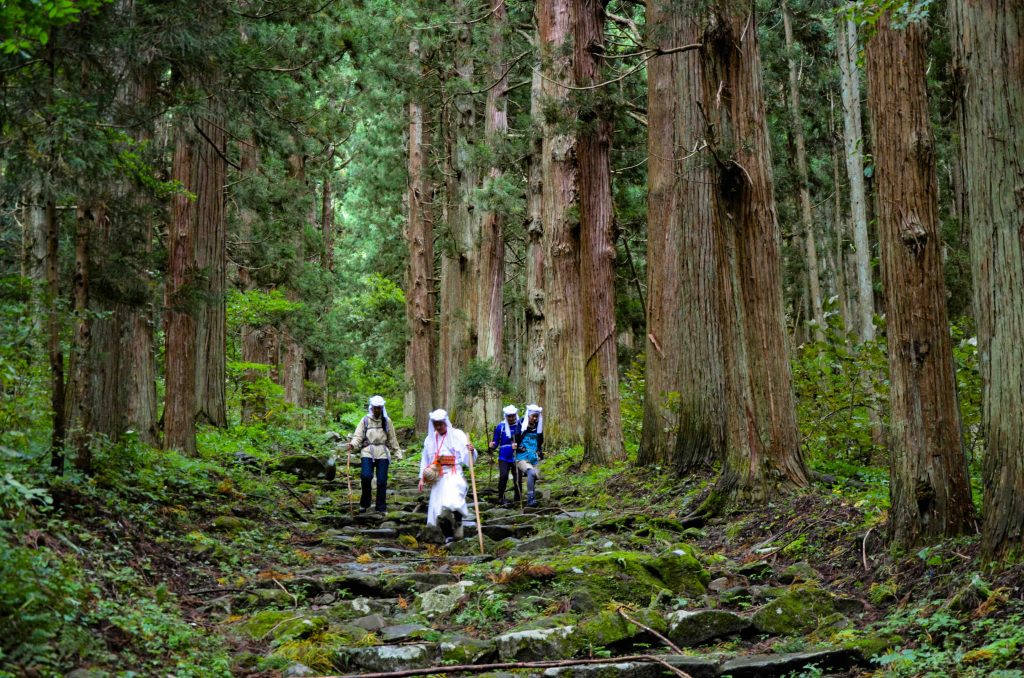
Until the Meiji era split between Shinto and Buddhism, Kosuge shrine was a New Shingon (Buddhist sect) temple known as Kosugezan-ganryuji. During this period, the temple flourished as one of the three most sacred areas for mountain ascetics in northern Nagano, alonside Togakushi and Iizuna. Although the circumstances of temple’s foundation have not been definitively established, chronicles of the time provide some clues to the temple’s origins; Searching various countries for a suitable place to promote Buddhist teachings, En-no-ozuno, the father of Shugendo Buddhism, happened upon Mt. Kosuge, founding a temple there in 680 AD. During the Daido Era (806-810 AD), Sakanoue-no-tamuramaro (early 9th century military officer) reached Mt. Kosuge, and rebuilt the Hasshogongen-honmiya and Kayakirido temples. He also founded the Shugenin and Kosugezan-ganryuji temples.
According to descriptions left behind in the temple, it appears that the god Kosugegongen (also known as Matarajin – Tendai sect of Buddhism) was worshipped in the temple. In addition, shrines were build to invite the appearance of the 7 buddhas, from Kumano, Kinpu (Yoshino province), Hakusan, Tateyama, Sanno, Hashiriyu, and Togakushi. During the late Heian era (12th century), Mt. Kosuge became further established through the influence of “Kumano Shugendo” and “True Form Manifestation” ideology.
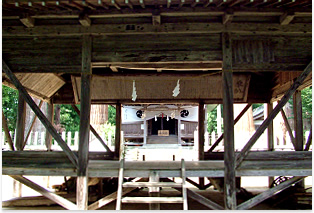
From the Kamakura period (1185-1333) until the beginning of the Nanbokucho Era (1336-1392), the southern Takanashi dynasty and the northern Ichikawa dynasty battled for control of the Kosuge area. Eventually, the Takanashi clan was defeated at Kosuge by an Ichikawa counter-attack. Subsequently, Muromachi shogunate rule led to stability in the area, and Mt. Kosuge enjoyed a period of prosperity as sacred ground for Shugendo (Japanese mountain asceticism-shamanism) practitioners. Over a period of four years, Ganryuji temple’s Gushabochujikan was rebuilt, an inner shrine was constructed, and two Kiritakehououmon-sukashibori-okushawakitake (openworks of phoenix) were created. In general, it’s thought that until the Muromachi era, the wide-scale construction efforts in Mt. Kosuge were made possible only by the area’s prosperity.
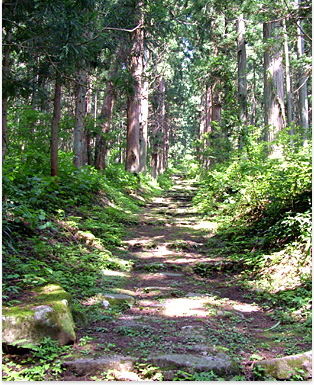
Decline and Reconstruction: The Warring States Period to Modern Day
During the Warring States Period (Mid 15th to 16th century), the Shinano region became a stage for battles between the feudal warlords Uesugi and Takeda, and the Mt. Kosuge area was placed under Uesugi protection. Although Kenshin Uesugi prayed at the mountain for victory in battle against Shingen Takeda, the Mt. Kosuge region’s good fortune lasted only until the Battle of Kawanakajima in 1567. At this battle Kenshin Uesugi was defeated, and the buildings of Ganryuji temple (except for the main building) burned to the ground by Takeda’s army. After Takeda’s eventual defeat by the Oda family, control of the region passed to Katsuyori Uesugi, and the main inner shrine was rebuilt during the subsequent period of stability.
During the Edo period, rehabilitation efforts were directed at the cedars along the path to the inner shrine, as well as various religious architecture, and the sacred area of Kosuge was removed from feudal protection and placed under the control of local villages. Religious services gradually gave way to festivals focused on entertainment and sightseeing for visitors.
During the Meiji Era, Buddhism and Shinto separated into two distinct disciplines. After the split, Ganryuji temple steward Daishoin-betto continued as a Shinto priest, and the temple’s Buddhist ritual tools were moved to Bodaiin temple. The temple itself became Kosugesha-hasho-daijin (Shrine of eight gods), and in 1900 the name was changed to Kosuge Shrine. This shrine was the foundation for the current Kosuge Shrine.
Through the cedar avenue to Kosuge inner shrine
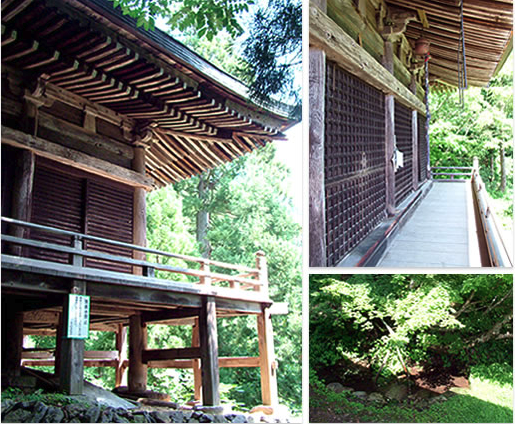
Kosuge Inner Shrine – Kosuge main shrine
The Kosuge Shrine inner sanctuary, where eight deities are enshrined, is located at an altitude of nearly 900meters above sea level. According to records, the shrine was originally restored in 1592. The main and auxiliary shrines were built during the mid-Muromachi period (1333-1573), and were designated as national “important cultural properties” in 1964.
The building faces southward, with a gabled roof entrance, while the northern face is backed against a rock wall. Leaving the north side unornamented, the eaves begin on the western side of the building, seeming to climb the stairs to the main shrine. Water drips from the rock face behind the building, forming a kanroike (a pond) in the inner shrine area. It’s said that when the pond first formed, it was used as an object of worship. Moreover, this shrine is the site of Kenshin Uesugi’s prayer for victory, offered just before dispatching troops to Kawanakajima. People came to worship from as far as Niigata Prefecture. The principle object of worship is a depiction of Hayagriva (horse-head kannon). However, with the exception of special days, including temple festivals, visitors cannot enter the temple. The inner building is also home to a tsuzumi-iwa (hand drum rock), which is said to make a noise similar to taiko drums when hit.
Incidentally, a sightseeing route passes over the Mt. Kosuge peak (1047 meters), connecting the mountain with Hokuryuko lake.
Historical buildings in Kosuge
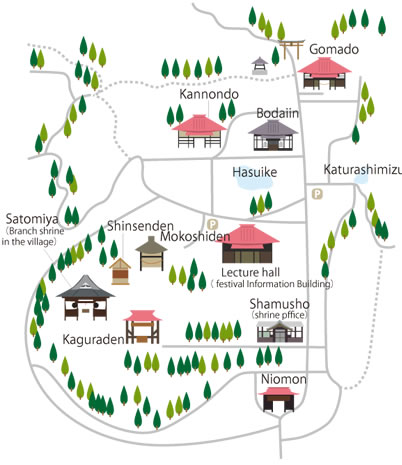
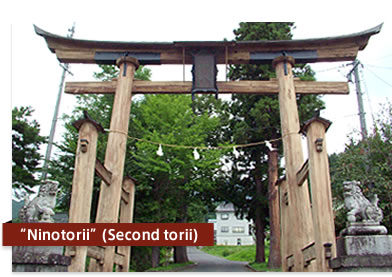
The large wooden gate at the Sekizawa entrance to Kosuge is called Nino-torii. Kosuge shrine stone pillars stand near this entrance, along with large stone lanterns and the traditional carvings of guardian dogs, and it shows here is the entrance of an approach to the shrine substantially. It is also said that the first torii was originally located on the left bank of the Chikuma River, beside the Ozeki Bridge (Okurazaki, Tokiwa district). It is currently 2 kilometers from the village center.
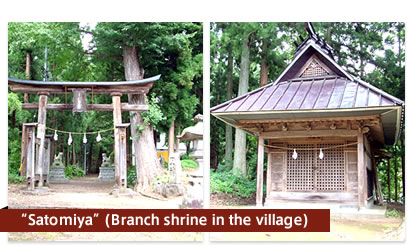
The ruins of Minami-Tatsuike and the Satomiya woods are located along the temple path, which runs east-west through the village center. The main shrine in Satomiya was rebuilt by Iiyama feudal lord Matsudaira in 1660. The currently existing buildings all underwent large-scale reconstruction in 1923. The Kagura-den (main shrine) sits at the top of a flight of stone steps. To the right, a mikoshi (portable shrine) is brought out once every three years, used to display the Hashiramatsu brushwood fire miracle. The Jinme-den (sacred horse palace) is located to the left.
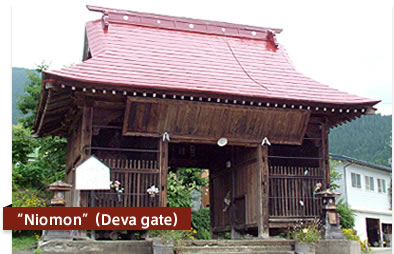
Ascending the steep path through the fields surrounding Nino-torii, the first shrine to appear is the gable-roofed Niomon. Originally built in the late 17th century (repaired in 1698) as Niodo temple’s western gate, statues of guardian gods are enshrined on both sides of the building. Also known as Niosondo, the building is no longer used as a gateway. Instead, it serves as a shrine to Nioson, god of good walking – zori (Japanese sandals) are often left as an offering. After the early Meiji Era decree separating Shinto and Buddhism, Daishoin was abandoned (its contents moved to Kosuge shrine) and many temple buildings were destroyed. Still, valuable ruins from ancient days still remain.
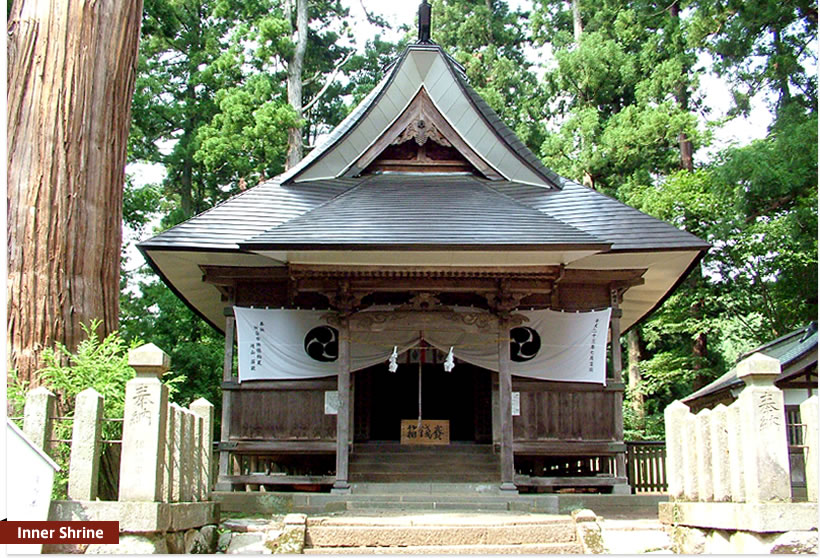
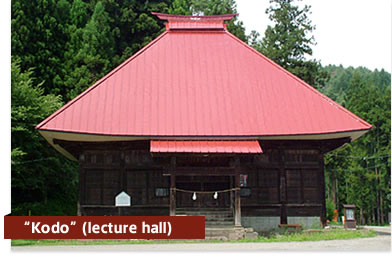
The lecture hall next to the village shrine originally belonged to Nakanoin of Ganryuji temple. Although the large and inner gates of the South entrance, as well as the main temple, were built nearby, these structures were burned down during the Warring States period Takeda invasion. The lecture hall was restored by Iiyama feudal lord Matsudaira in 1697. Three Amitabha are enshrined inside, and once every three years, the Hashiramatsu brushwood fire ritual is observed in mid July.
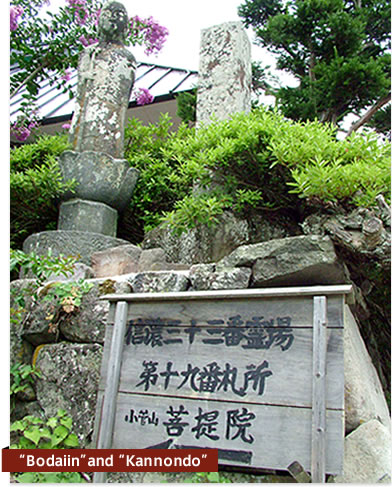
As the 19th in a tour of 33 holy temples in the Shinano region, Kannondo (temple dedicated to the Kannon) has many visitors. Although the temple was formerly located hallway up Mt. Kosuge, it was moved to its present location, and is now administered by Bodaiin temple. As for Bodaiin, it was originally known as Sakurahonbo, one of the mountain locations of Daishoin Temple. Restored and reopened in the early 18th century, the temple (Shingon Buddhism, Chisan sect) is dedicated to the deity Mahavairocana. During the period of anti-Buddhism sentiment in the early Meiji Period, Daishoin temple was merged into Kosuge Shrine. However, Sakurahonbo remained a Buddhist temple, called Bodaiin, receiving all the Buddhist objects of worship from Daishoin.
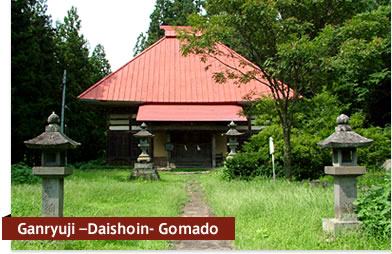
During Ganryuji’s golden period, it’s said that the temple had 16 upper temple halls, 10 middle temple halls, and 11 lower temple halls (37 total). With more than 100 affiliated temples, 6 shrines, and 5 halls, the complex also boasted a population of 300 mountain ascetics, itinerant priests, and monks. Daishoin temple stood at the top of all these temples and shrines. Currently, Gomado temple stands on the site of Ganryuji-bettou-Daishoin, and serves as the starting point for the Hashiramatsu event, as well as hosting Kakoyaki religious services at the side of the temple. This building underwent reconstruction in 1750.
Kosuge Shrine is home to the God of marriage?
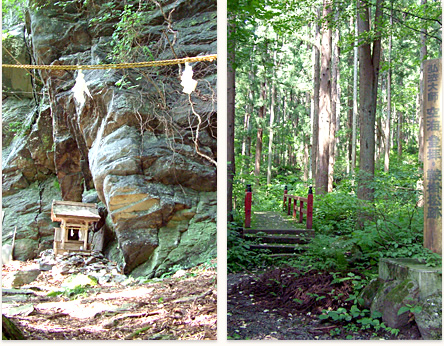
In historic Kosuge, various tales and legends remain from the old days. One such story is told about match-making.
One day, while worshipping at Kosuge shrine, a lord of Kaga fell in love at first sight with a beautiful girl, and made her his wife. Not long after, the couple was blessed with a healthy child. Overjoyed, the lord proclaimed the easy birth a blessing of the Hayagriva deity, and donated the 600-volume Great Perfection of Wisdom Sutra to the shrine. Since that time, Kosuge Shrine’s deity has been worshiped as a God of matchmaking by local people. Kosuge is well-known as a popular place for proposals, and the number of women worshiping at the shrine is said to have particularly increased. Along the path to the shrine, landmarks include Yume-no-kayoi bashi (bridge of dreams), crossed by Kobo-daishi Kukai (9th century priest) and said to ensure happiness. At nearby Aizen-iwa (Aizen rock), the deity Ragaraja, said to fulfill wishes for love, is deified.



